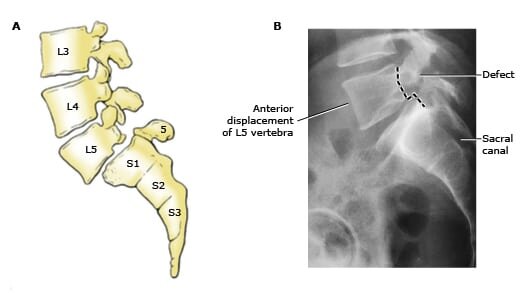Spondylolysis vs. Spondylolisthesis: Differences & Treatment
Spondylolisthesis Diagnosis and Treatment: A Simple Guide
Spondylolisthesis is a condition where one bone in your spine (vertebra) slips forward over the one below it. This can cause pain, weakness, and nerve issues. Getting an early diagnosis of spondylolisthesis is important to stop symptoms from getting worse and to find the best treatment options for spondylolisthesis. This guide will explain how spondylolisthesis is diagnosed and the best non-surgical and surgical treatments to manage the condition.
What is Spondylolisthesis?
Spondylolisthesis can happen for different reasons, such as birth defects, aging, injuries, or stress on the spine. The most common types are:
Isthmic spondylolisthesis – Happens due to a small fracture in the spine from repeated stress, common in athletes.
Degenerative spondylolisthesis – Caused by aging and wear and tear on the spine, usually in older adults.
Congenital spondylolisthesis – Present at birth due to spine abnormalities.
Traumatic spondylolisthesis – Happens after a sudden injury to the spine.
Spondylolithesis of L5 and S1
This is an example of what is called an isthmic spondylolithesis. It is caused by small fracture in the spine typically from repeated stress
Symptoms of Spondylolisthesis
Symptoms vary depending on how severe the vertebra has slipped. Common signs include:
Lower back pain that gets worse with activity.
Tight hamstrings, making it hard to bend or stand for long periods.
Numbness, tingling, or weakness in the legs from nerve pressure.
Difficulty walking or standing upright.
Loss of bladder or bowel control (this is rare but serious and needs immediate medical attention).
How Doctors Diagnose Spondylolisthesis
A doctor will use a mix of medical history, a physical exam, and imaging tests to confirm spondylolisthesis.
1. Medical History and Physical Exam
A doctor will ask about your symptoms and any past injuries or activities that might have put stress on your spine. They will also check for muscle weakness, flexibility issues, and nerve symptoms.
2. Imaging Tests
To confirm the diagnosis of spondylolisthesis, doctors may use:
X-rays – The most common test to check for vertebra misalignment.
MRI (Magnetic Resonance Imaging) – Shows nerve compression, soft tissues, and spine instability.
CT Scan (Computed Tomography) – Provides detailed images of bones and fractures.
Non-Surgical Treatments for Spondylolisthesis
Most people with spondylolisthesis can manage symptoms with non-surgical pain relief treatments. These include:
1. Physical Therapy and Exercise
A physical therapy program for spondylolisthesis can help strengthen muscles and improve posture. Recommended exercises include:
Core exercises to support the lower back.
Stretching to reduce muscle tightness.
Low-impact activities like swimming or walking to keep the spine moving without too much stress.
2. Pain Medications
NSAIDs (Non-Steroidal Anti-Inflammatory Drugs) such as ibuprofen or naproxen can reduce pain and swelling.
Muscle relaxants can help with severe muscle spasms.
Epidural steroid injections provide temporary relief by reducing inflammation around the nerves.
3. Lifestyle Changes and Bracing
Avoiding heavy lifting or activities that strain the lower back.
Maintaining a healthy weight to reduce stress on the spine.
Bracing may help stabilize the spine, especially in younger patients.
Surgical Options for Spondylolisthesis
If non-surgical treatments don't work, or if the vertebra has slipped too far, surgery for spondylolisthesis might be needed.
1. Spinal Fusion Surgery
This surgery joins two or more vertebrae together using bone grafts, rods, and screws to stabilize the spine.
2. Decompression Surgery (Laminectomy)
If nerves are compressed, part of the vertebra may be removed to relieve pressure before performing a spinal fusion.
3. Minimally Invasive Surgery
Some newer minimally invasive spine surgeries involve smaller incisions, leading to faster recovery times and fewer complications.
Recovery and Long-Term Care
With proper treatment for spondylolisthesis, most people can get pain relief and return to normal activities. Recovery steps include:
Physical therapy to regain strength and flexibility.
Slow return to normal activities, with care to avoid reinjury.
Lifestyle adjustments to protect the spine and prevent future issues.
Final Thoughts
Early diagnosis of spondylolisthesis and a personalized treatment plan are key to managing symptoms. Whether you choose non-surgical treatments like physical therapy and medication or surgical intervention, the right care can help you live a more active, pain-free life. If you think you may have spondylolisthesis, consult a spine specialist like Dr. Jerry Sobel at Sobel Spine & Sports to explore the best treatment options for you.

